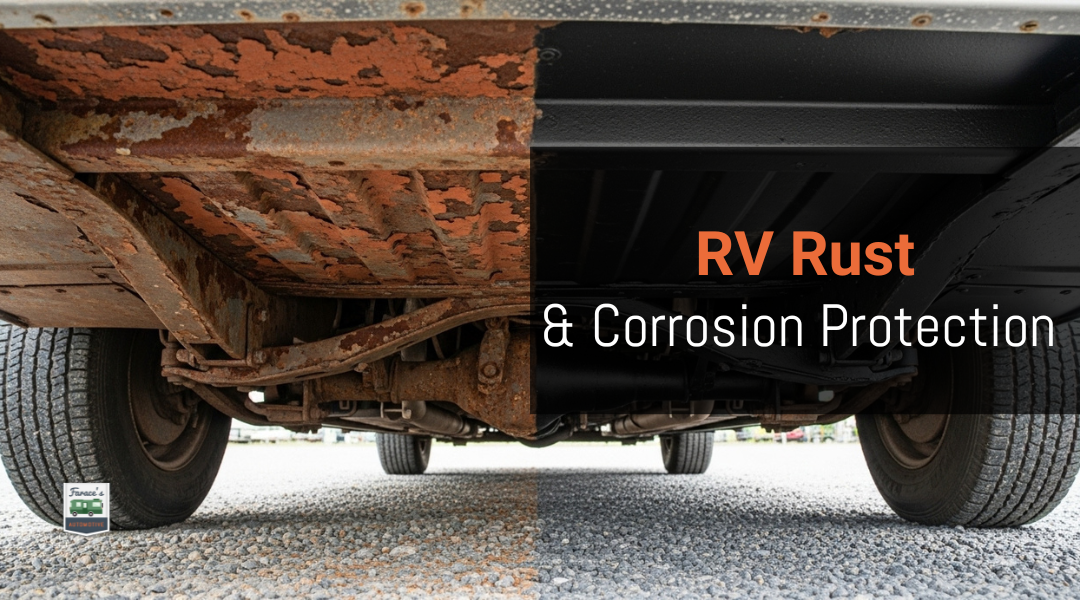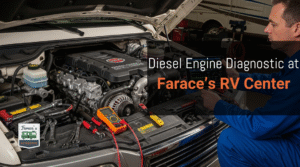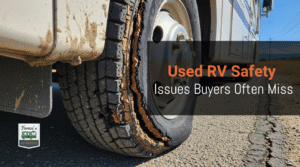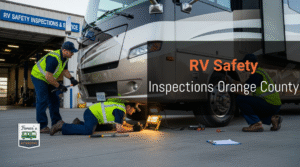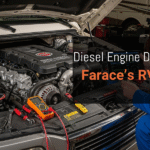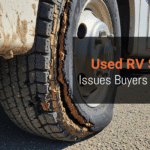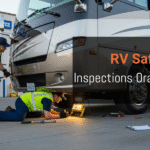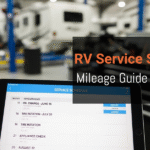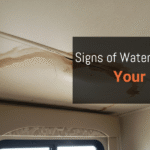California’s coastal environment presents unique challenges for RV owners, with salt air, high humidity, and constant exposure to ocean winds creating the perfect conditions for rust and corrosion. The combination of salt spray and moisture can cause significant damage to your RV’s metal components, electrical systems, and structural integrity within just a few years if left unprotected. These environmental factors make proactive rust prevention essential rather than optional for RV owners in areas like Huntington Beach.
Understanding the early warning signs of corrosion and implementing proper protective measures can save thousands of dollars in repair costs down the road. The salt-laden air doesn’t just affect exterior surfaces – it penetrates into hidden areas where rust can develop unnoticed until major damage occurs. Many RV owners discover too late that their investment has suffered extensive deterioration that could have been prevented with regular maintenance and professional protection services.
This guide explores the specific risks facing RVs in coastal California, how to identify potential problems before they become costly repairs, and the proven strategies that keep recreational vehicles protected from the harsh marine environment. Whether dealing with existing corrosion issues or looking to prevent future damage, understanding these factors helps RV owners make informed decisions about protecting their investment.
Why Coastal California Puts RVs at Risk for Rust and Corrosion
Coastal California’s salt-laden air and high humidity levels accelerate oxidation on metal surfaces. RVs face constant exposure to corrosive elements that penetrate frames, undercarriages, and electrical systems.
The Impact of Salt Air and Ocean Humidity
Salt particles from ocean spray travel several miles inland, reaching RVs parked throughout coastal California. These microscopic particles settle on metal surfaces and create an electrochemical reaction when combined with moisture.
Primary corrosive factors include:
- Sodium chloride concentration in coastal air
- Relative humidity levels above 70%
- Temperature fluctuations between day and night
- UV radiation that weakens protective coatings
The salt acts as a catalyst, speeding up the oxidation process by up to 10 times compared to inland environments. Humidity provides the moisture needed for rust formation.
Metal components begin showing corrosion within months rather than years. Aluminum parts develop pitting while steel surfaces form red oxide layers.
Common Areas of an RV Affected by Corrosion
Frame and chassis components suffer the most damage from salt exposure. The undercarriage collects salt spray and moisture, creating ideal conditions for rust formation.
Electrical connections and wiring corrode rapidly in coastal environments. Salt buildup causes poor conductivity and system failures.
Key vulnerable areas:
- Hitch assemblies and safety chains
- Brake components and axles
- Exterior trim and fasteners
- Slideout mechanisms
- Awning hardware
Water and waste systems experience accelerated deterioration. Metal fittings, valves, and tank connections develop leaks from corrosion damage.
Exterior appliances like air conditioning units show corrosion on coils and mounting brackets. Propane system components require frequent inspection due to safety concerns.
Long-Term Risks if Rust Is Ignored
Structural integrity becomes compromised when rust weakens load-bearing components. Frame damage can make an RV unsafe for travel and void insurance coverage.
Financial consequences escalate quickly:
- Complete frame replacement: $15,000-$25,000
- Electrical system overhaul: $3,000-$8,000
- Slideout mechanism repair: $2,000-$5,000
Safety systems fail when corrosion affects brakes, hitches, or electrical connections. These failures create liability risks and potential accidents.
Resale value drops significantly on RVs with visible rust damage. Buyers avoid corroded units, making them difficult to sell.
Advanced corrosion leads to:
- Structural collapse of slideouts
- Complete brake system failure
- Electrical fires from corroded wiring
- Water damage from failed plumbing connections
Prevention costs significantly less than major repairs or replacement.
Signs Your RV May Already Have Rust or Corrosion
Early detection of rust and corrosion prevents costly repairs and structural damage. RV owners should inspect specific areas where moisture accumulates and metal components face constant exposure to coastal elements.
Visible Exterior Rust Spots
Surface rust appears as reddish-brown spots on exterior panels, door frames, and metal trim. These spots often start small but expand rapidly in coastal environments.
Check around exterior storage compartments where hinges and latches show frequent wear. Salt air accelerates corrosion in these high-contact areas.
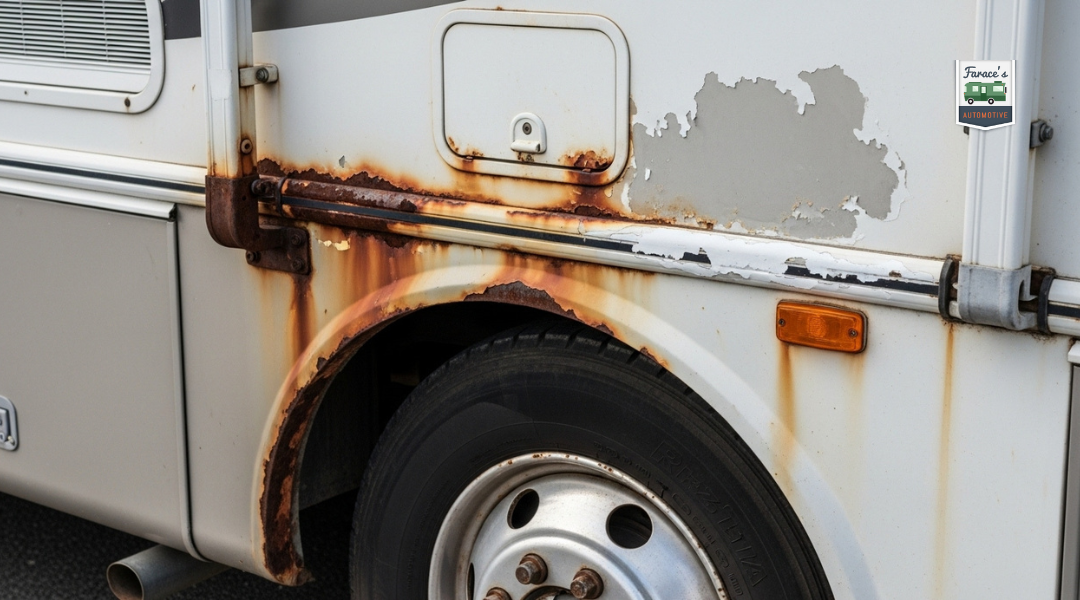
Paint bubbling indicates rust forming underneath the surface. The paint lifts and creates small bubbles before flaking away completely.
Wheel wells collect road salt and moisture, making them prime locations for rust development. Inspect behind plastic covers and trim pieces where water can pool.
Chrome and aluminum components develop white, powdery deposits called oxidation. This appears different from iron rust but causes similar structural weakening over time.
Undercarriage and Frame Damage
The chassis and frame rails face constant exposure to road spray containing salt and chemicals. Look for flaking metal, dark stains, or rough texture on steel components.
Suspension components including springs, shock mounts, and axles show rust through surface pitting and metal deterioration. These areas require immediate attention for safety reasons.
Cross members and support brackets often develop rust at connection points where dissimilar metals meet. Water collects in these joints and accelerates galvanic corrosion.
Propane tank mounting hardware and electrical connections corrode quickly in coastal areas. Check for green deposits on copper connections and white powder on aluminum components.
Inspect the hitch assembly and safety chain attachment points. These high-stress areas can fail catastrophically if rust compromises structural integrity.
Corrosion Around Roof, Windows, and Seals
Roof edges and gutters collect water and debris, creating perfect conditions for rust formation. Check where metal roofing meets sidewalls and around vent penetrations.
Window frames develop corrosion where rubber seals meet metal components. Look for dark stains, gap formation, or seal separation from the frame.
Awning hardware and support arms show rust at pivot points and adjustment mechanisms. Salt spray reaches these elevated components during windy conditions.
Door frames exhibit corrosion around lock mechanisms and handle assemblies. Water infiltration through worn seals accelerates metal deterioration in these areas.
Exterior light fixtures and their mounting hardware corrode where moisture enters electrical connections. Check for white or green deposits around bulb sockets and wire connections.
Electrical and Mechanical Issues Caused by Rust
Battery terminals develop thick corrosion buildup that appears white or blue-green. This prevents proper electrical connections and reduces charging efficiency.
12-volt systems experience intermittent failures when corrosion affects ground connections and junction boxes. Lights dim, pumps cycle irregularly, or components stop functioning entirely.
Slide-out mechanisms bind or operate slowly when rust affects rails, gears, and motor assemblies. Listen for grinding noises or jerky movement during operation.
Appliance connections suffer from corroded gas lines and electrical terminals. Water heaters, furnaces, and refrigerators may operate poorly or create safety hazards.
Shore power connections develop dangerous arcing conditions when corrosion affects plug contacts and panel connections. This creates fire risks and electrical system damage.
Preventive Steps to Protect Your RV from Rust
Taking proactive measures against rust requires consistent maintenance routines that address salt exposure, protective barriers, structural vulnerabilities, and proper storage practices. These four essential strategies work together to create a comprehensive defense system against coastal corrosion.
Regular Washing and Salt Removal After Coastal Trips
Salt particles from ocean air and beach visits create the primary threat to RV metal components. Washing the RV after every coastal trip removes these corrosive deposits before they penetrate protective finishes.
Washing frequency matters significantly. RV owners should rinse their vehicles within 24 hours of beach exposure. This timeframe prevents salt from crystallizing and embedding into surface materials.
The washing process requires specific attention to hidden areas. Salt accumulates in door hinges, awning mechanisms, and slide-out seals where standard washing might miss it.
Key washing steps include:
- Rinse thoroughly with fresh water
- Use RV-specific soap to avoid damaging seals
- Focus on undercarriage areas where salt spray collects
- Clean around vents and exterior fixtures
Water temperature should remain lukewarm to prevent thermal shock to seals and plastics. Hot water can damage rubber components while cold water fails to dissolve salt deposits effectively.
Applying Protective Coatings and Sealants
Protective coatings create physical barriers between metal surfaces and corrosive elements. UV-protectant wax or sealant should be applied at least twice yearly to maintain effective protection.
Wax selection impacts protection levels. Synthetic sealants formulated specifically for RVs offer superior durability compared to standard automotive products. These specialized formulations resist salt penetration more effectively.
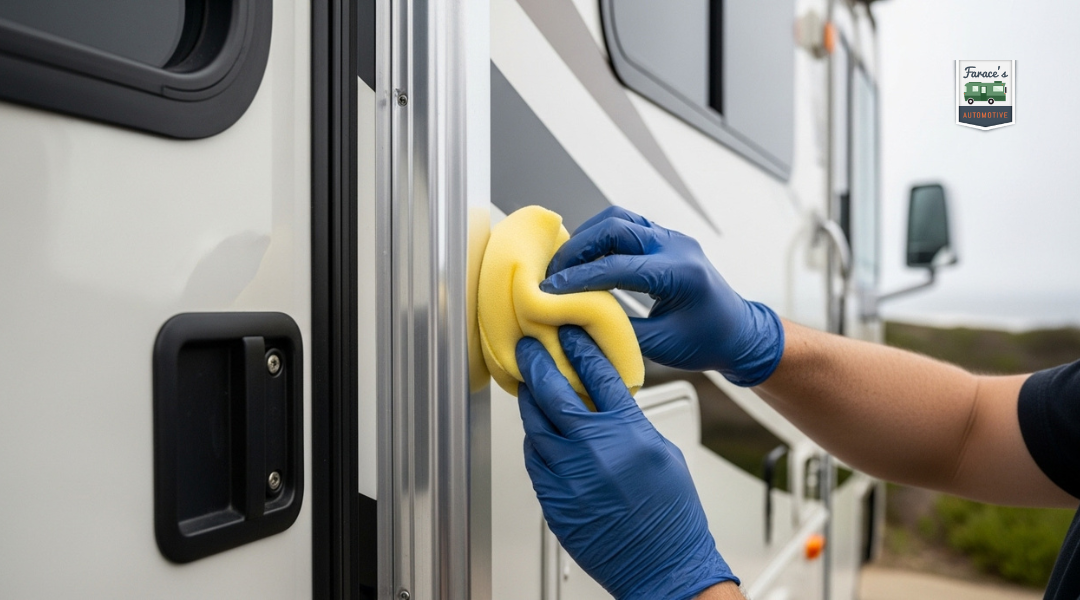
Application timing affects coating performance. Apply protective products during mild weather conditions when temperatures range between 60-80°F for optimal adhesion.
Essential coating areas include:
- Exterior metal trim and fixtures
- Door frames and window surrounds
- Roof vents and antenna mounts
- Hitch and tongue assemblies
Multiple thin coats provide better protection than single thick applications. Allow each coat to cure completely before applying additional layers.
Undercarriage Inspections and Treatments
The undercarriage faces constant exposure to road salt, moisture, and debris that accelerate corrosion. Monthly visual inspections help identify rust formation before it becomes structural damage.
Professional rustproofing treatments like POR-15 offer long-term protection for chassis components. These products convert existing rust to stable iron oxide while preventing new corrosion.
Spray-on preventatives access hidden areas inside chassis rails and behind panels. These treatments reach locations where manual application proves difficult or impossible.
Inspection checklist includes:
- Frame rails and cross members
- Suspension mounting points
- Brake lines and fuel tank straps
- Electrical connections and grounding points
Small rust spots require immediate treatment. Sand affected areas to bare metal, apply rust converter, then finish with protective paint designed for metal surfaces.
Storing Your RV Properly in a Coastal Climate
Storage location significantly impacts rust development rates. Indoor storage facilities provide the best protection from salt air and humidity fluctuations.
Ventilation prevents moisture accumulation inside stored RVs. Crack roof vents slightly and use moisture absorbers to maintain dry interior conditions.
Ground contact creates corrosion risks. Store RVs on concrete pads or gravel surfaces rather than directly on grass or dirt where moisture retention increases.
Proper storage preparation involves:
- Cleaning and drying all surfaces thoroughly
- Applying protective coatings to vulnerable areas
- Covering or sealing exterior openings
- Installing tire covers to prevent UV damage
Battery maintenance during storage prevents acid leaks that cause severe metal corrosion. Remove batteries or maintain proper charge levels using trickle chargers designed for RV applications.
Professional Rust Prevention and Repair Services in Huntington Beach
Farace Automotive & R.V. Center employs comprehensive inspection methods to detect early-stage corrosion and utilizes specialized treatments to restore and protect RV surfaces from coastal salt damage.
How Farace Automotive Inspects for Hidden Corrosion
The inspection process begins with a thorough examination of high-risk areas where moisture accumulates. Technicians focus on slide-out mechanisms, window frames, and exterior storage compartments where water penetration commonly occurs.
Visual Assessment Areas:
- Frame joints and weld points
- Electrical connection points
- Awning brackets and mounting hardware
- Undercarriage components
Advanced inspection tools detect corrosion beneath paint and protective coatings. Moisture meters identify areas with elevated humidity levels that indicate potential water intrusion.
The team examines interior walls and ceiling areas for discoloration or soft spots. These signs often reveal hidden moisture damage before visible rust appears on exterior surfaces.
Advanced Techniques for Rust Removal and Treatment
Surface preparation involves removing loose rust through mechanical abrasion and chemical treatments. Wire brushing and sandblasting eliminate corrosion while preserving the underlying metal structure.
Treatment Process Steps:
- Rust neutralization using phosphoric acid-based solutions
- Metal conditioning to create optimal surface adhesion
- Primer application with corrosion-inhibiting compounds
Chemical rust converters transform existing corrosion into a protective barrier. This process stabilizes affected areas and prevents further oxidation damage.
Electrolytic rust removal techniques handle severe corrosion cases. The process uses controlled electrical current to dissolve rust without damaging the base metal.
Protective Coating and Resealing Services
Multiple coating layers provide comprehensive protection against salt air exposure. The base coat contains rust inhibitors while the topcoat offers UV and moisture resistance.
Coating Application Sequence:
- Primer with zinc phosphate additives
- Intermediate barrier coating
- Finish coat with marine-grade durability
Sealant application targets vulnerable joints and seams where water infiltration occurs. Technicians remove old caulking and apply fresh marine-grade sealants to windows, vents, and exterior fixtures.
Undercoating services protect the RV’s chassis and frame components. Specialized rubberized compounds create a flexible barrier against road salt and moisture exposure.
Routine Maintenance Programs for Long-Term Protection
Annual inspection schedules identify potential corrosion issues before extensive damage occurs. The program includes detailed documentation of problem areas and preventive treatment recommendations.
Maintenance Schedule Components:
- Quarterly exterior wash and inspection
- Semi-annual sealant condition assessment
- Annual comprehensive corrosion evaluation
Preventive treatments include regular application of corrosion inhibitors to exposed metal surfaces. The service extends coating life and maintains protective barrier integrity.
Documentation tracking helps RV owners monitor their vehicle’s condition over time. Detailed records identify patterns and guide future maintenance decisions for optimal protection.
Cost Considerations: Prevention vs. Repair
Preventive maintenance costs significantly less than major rust repairs in coastal environments. Regular protective treatments range from $200-800 annually, while extensive corrosion damage can require thousands in structural repairs.
Why Preventive Care Saves Money Over Time
Regular maintenance creates a protective barrier against salt air damage. Annual treatments cost $200-400 for basic protection services. This includes washing, waxing, and applying protective coatings to vulnerable areas.
Major rust damage requires structural repairs costing $2,000-8,000 or more. Frame damage from neglected corrosion often exceeds the RV’s value. Preventive care costs represent 5-10% of potential repair expenses.
Monthly washing and quarterly protective treatments prevent salt buildup. These simple steps cost under $100 monthly when done professionally. The alternative involves replacing corroded components, repairing structural damage, and addressing safety issues.
Insurance rarely covers corrosion damage from poor maintenance. RV owners bear the full cost of neglect-related repairs.
Typical Costs for Rust Repair vs. Maintenance Services
Preventive Services:
- Monthly wash and inspection: $40-60
- Quarterly protective coating: $150-250
- Annual comprehensive treatment: $300-500
Repair Costs:
- Minor rust spot treatment: $200-500 per area
- Frame section replacement: $1,500-4,000
- Extensive structural repair: $5,000-12,000
Coastal RV owners spend 3-5 times more on repairs than maintenance when prevention is ignored. Early-stage rust treatment costs $300-800 per affected panel. Advanced corrosion requires complete component replacement.
Professional maintenance services offer package deals reducing individual service costs. Many shops provide annual contracts covering regular treatments at discounted rates.
Why Choose Farace Automotive & R.V. Center for Rust Protection
Farace Automotive & R.V. Center brings four decades of specialized experience to coastal California RV owners facing unique corrosion challenges. Their veteran-family ownership, advanced technology paired with traditional craftsmanship, and established reputation throughout Orange County set them apart in rust prevention and treatment services.
Veteran-Family-Owned with 40+ Years of Local Experience
Farace Automotive & R.V. Center operates as a veteran-family-owned business with over four decades serving the Huntington Beach area. This longevity provides deep understanding of how coastal California’s salt air affects different RV materials and components.
The family ownership structure ensures consistent service standards and long-term customer relationships. Veteran leadership brings discipline and attention to detail that proves essential when addressing rust prevention protocols.
Their 40+ years of operation means they have witnessed the evolution of RV construction materials and corrosion protection methods. This experience allows them to recommend appropriate treatments for vintage RVs with different metal compositions as well as modern units with advanced materials.
Local expertise matters significantly in coastal environments. They understand which RV areas are most vulnerable to salt corrosion in Huntington Beach’s specific climate conditions.
“New World Technology – Old World Craftsmanship” in Every Repair
Farace combines modern rust detection equipment with traditional hands-on inspection techniques. Their technicians use advanced diagnostic tools to identify hidden corrosion while applying proven craftsmanship methods for thorough treatment.
Modern technology includes:
- Electronic rust detection systems
- Advanced coating application equipment
- Precision cleaning tools for surface preparation
Traditional craftsmanship involves:
- Detailed hand inspection of vulnerable areas
- Manual surface preparation techniques
- Careful application of protective treatments
This dual approach ensures comprehensive rust protection coverage. Technology identifies problems early, while experienced craftsmanship ensures proper treatment application that withstands coastal conditions.
The combination prevents both surface-level rust and deeper structural corrosion issues that automated processes might miss.
Trusted by RV Owners Across Orange County and Coastal California
Farace has built a reputation serving RV owners throughout Orange County’s coastal communities where salt air creates persistent corrosion challenges. Their client base includes owners from Newport Beach, Laguna Beach, Dana Point, and surrounding coastal areas.
Key trust indicators include:
- Repeat customers returning for annual rust protection services
- Referrals from RV dealerships in the region
- Positive reviews specifically mentioning rust prevention success
Their understanding of coastal RV storage challenges helps owners make informed decisions about protection frequency and treatment types. Many clients schedule regular maintenance specifically for rust prevention based on their recommendations.
The shop’s location in Huntington Beach positions them centrally for Orange County RV owners seeking specialized coastal corrosion expertise.

